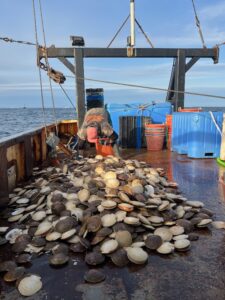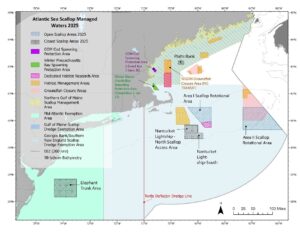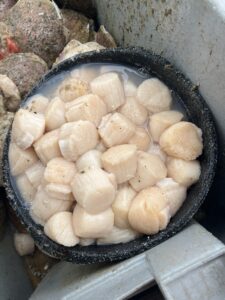PROVINCETOWN — State data finalized in April show that 2024 saw the smallest sea scallop haul from the Outer and Lower Cape’s ports since at least 2019. The in-shell weight of scallops unloaded in Provincetown, Wellfleet, and Chatham fell by more than half from the previous year, from 4.1 million pounds in 2023 to 1.7 million pounds last year.

As recently as 2021, the three ports had combined for 5.4 million pounds of in-shell scallop landings — three times what was caught in 2024.
The wholesale value of the 2021 catch was $10.4 million, according to data provided to the Independent by the state Div. of Marine Fisheries. Even though prices have increased on a per-pound basis since 2021, the wholesale value of 2024’s catch was only $4 million — less than half the number from three years before.
Last year, $2.8 million worth of scallops were unloaded in Provincetown, while the total proceeds were $787,000 in Chatham and $435,000 in Wellfleet.
There are several reasons for the rapid decline in the amount of scallops unloaded in these ports, scallopers Damian Parkington and Ryan Tavares told the Independent.
Federal regulations for scalloping are complex, and the locations that can be fished change nearly every year. This year, a large area in the northern Gulf of Maine could be fished only between April 1 and April 28.
Tavares, who lives in Fairhaven and captains the F/V Outlaw and the F/V Jessica Heather, said the trip from that fishing ground to Provincetown Harbor is only “nine hours dock-to-dock.”
“We were only fishing for maybe half an hour, one or two tows, and only dragging it for maybe 10 minutes at a time” to reach the limit of 200 pounds of scallop meat or 1,666 pounds of in-shell scallops, Tavares said. At current wholesale prices, that means a one-day trip can produce $7,000 in revenue, he said — about $35 per pound of meat.
Although it might seem extreme, the closure of the northern Gulf of Maine in late April is “what keeps that fishery so plentiful,” Tavares said.
The regulations are also different for the smaller boats that participate in the National Marine Fisheries Service’s “limited access general category” quota system for scallop boats, as compared to the “limited access” boats that are much larger and spend more time at sea.

The Marine Fisheries Service, which is a part of the National Oceanic and Atmospheric Administration, created the limited access general category in 2008 specifically to preserve a part of the scallop fleet “made up of relatively small vessels,” with catch limits designed “to maintain the historical character of this fleet and provide opportunities to various participants including vessels from smaller coastal communities,” according to a 2017 federal review of those rules.
The categories are not directly defined by the vessel’s length but rather by the number of crew that can work aboard and the number of days they can spend at sea.
Only 5.5 percent of the North Atlantic harvest is reserved for the smaller “general category” boats, however.
The other 94.5 percent of the $360 million scallop harvest goes to the much larger “limited access” boats, which are mostly based in New Bedford, as well as in Cape May, N.J. and Norfolk, Va.
“Limited access” vessels are allowed to harvest 12,000 pounds of scallop meat at a time under this year’s rules — completely dwarfing what the smaller vessels can take.
Because of the shifting areas in which scallopers are allowed to fish, they will sometimes land their catch in different ports, said Parkington, who lives in Wellfleet and captains the F/V Clean Sweep and the F/V Roen Kiel.
Parkington sometimes lands his catch in Gloucester when he is fishing the northern Gulf of Maine, he said, while Tavares said he expects to land scallops in Hyannis this year when a fishing area near the Great South Channel, which lies between the Nantucket Shoals and Georges Bank, is opened for the first time in several years.
In addition to the constantly changing map of where smaller vessels can fish, there is also the issue of declining overall catch limits, Parkington and Tavares both said. In 2021, the entire limited access general category fleet — also known as the “day boat” fleet — were allowed by federal rules to land 1.9 million pounds of scallop meat.
This year, that catch allowance is 992,000 pounds of meat — less than half of the 2021 number.
“The newer guys are all getting nervous because there’s less scallops out there,” Tavares said.

Parkington said that his Roen Kiel will continue fishing for scallops this year, but his Clean Sweep will likely be fishing for lobster.
Alex Hay, who buys directly from fishing vessels through his Wellfleet Shellfish Co., said the decreased supply and increased prices of scallops on the Outer Cape has led him to stop selling scallop meat at retail outlets.
He used to buy 600 pounds of shucked scallop meat right off of local boats, Hay said, but he’s now focused on serving restaurants rather than the retail market. The lack of a steady supply is part of the problem.
“If you don’t have product to sell, you lose your customers, and you can’t just turn it back on” when times are better, Hay said.
That means scallops are scarcer and more expensive here than they used to be — a situation that might not change unless catch limits for the scallop fleet rise again.
